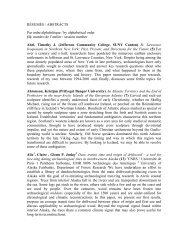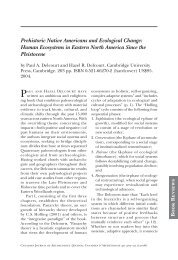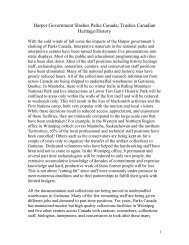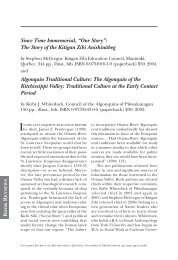16 - 20 MAI MAY 16 - 20 - Canadian Archaeological Association
16 - 20 MAI MAY 16 - 20 - Canadian Archaeological Association
16 - 20 MAI MAY 16 - 20 - Canadian Archaeological Association
Create successful ePaper yourself
Turn your PDF publications into a flip-book with our unique Google optimized e-Paper software.
un site qui était jusqu’alors mal connu et de confirmer son potentiel<br />
archéologique.<br />
Gilliland, Krista (Western Heritage, St. Albert, AB) • The Hearth<br />
and the Hummock: A sediment-based record of cultural activities at the<br />
Fort Denison site near Humboldt, Saskatchewan [31]<br />
Two key features were recovered during excavations at Fort Denison.<br />
The first is a hearth demonstrating multiple uses, and the second is<br />
a low sandy hill-like feature bounded by upper and lower layers of<br />
clay-rich sediment, interpreted as representing a defensive trench<br />
or zareba. The working hypothesis is that both features date to the<br />
military occupation of the fort, and geoarchaeological work was undertaken<br />
to investigate their formation and relative chronology. Preliminary<br />
results of stratigraphic and micromorphological analyses<br />
demonstrate that episodes of hearth use were interrupted by periods<br />
of disuse and possible site abandonment, and that it later functioned<br />
as a pit for domestic waste. These analyses also support a cultural<br />
origin for the hill-like feature and indicate that it precedes the formation<br />
of the hearth. These investigations suggest a broader history of<br />
cultural activity at Fort Denison that includes the periods preceding<br />
and post-dating military occupation of the site.<br />
Gilliland, Krista (Western Heritage, St Albert), W. Paul Adderley<br />
(University of Stirling), Terrance Gibson (Western Heritage,<br />
St Albert), Dave Norris (Western Heritage, Winnipeg) • Context,<br />
Chronology, and Culture: Problem-based Geoarchaeology at the Lakehead<br />
Complex Sites, Thunder Bay [19]<br />
With the goal of advancing site interpretations to include the broader<br />
landscape and cultural contexts, geoarchaeological work at the Lakehead<br />
Complex/Interlake Complex sites in the Thunder Bay region<br />
is addressing three fundamental problems. Firstly, we comment on<br />
the nature and extent of disturbance and redeposition at these sites.<br />
Secondly, we investigate the origin of pit-like depressions that are<br />
frequently associated with more deeply buried artifact-bearing sediments.<br />
Thirdly, we address the relative lack of a detailed chronology<br />
for these sites. Using a combination of stratigraphic and thin section<br />
analyses, luminescence profiling, and optical dating, we document<br />
the depositional history of predominantly artifact-bearing sediments<br />
to construct key stratigraphic and chronological frameworks for the<br />
site complex. Our work has broader resonance with current issues<br />
regarding interpreting archaeological sites in fluvial landscapes, establishing<br />
chronologies at sites with poor organic preservation, and<br />
employing sediment-based evidence to further understandings of<br />
sites found in Boreal forest settings.<br />
Gillot, Céline (Doctorante, Département d’Anthropologie, Université<br />
de Montréal) • The role of thin section petrography in the<br />
understanding of ancient architectural practices: A case study from the<br />
Maya site of Río Bec (Mexico) [21]<br />
Despite the significant achievements made over the last few decades<br />
in the scientific examination of archaeological materials and the constant<br />
development of new efficient analytical techniques, conventional<br />
thin section petrography continues to hold an important place in<br />
the archaeologist’s toolkit. Simple observation of thin sections with a<br />
polarizing microscope still has the potential to provide large amount<br />
of information not easily obtained by other methods. In some cases,<br />
this basic method can even be sufficient to answer the archaeologists’<br />
questions. Using as an example the work carried out on the building<br />
materials employed in the prehispanic Maya site of Río Bec, this<br />
presentation aims to demonstrate how valuable petrographic analyses<br />
are for the understanding of past architectures in particular. They<br />
may bring new insights not only on the building materials and the<br />
construction techniques, but also on the technological choices made<br />
by the builders and the reasons behind these choices.<br />
Girard-Rheault, Marilyn, (Université de Montréal) • Les camélidés<br />
et l’archéologie péruvienne [1]<br />
Les camélidés furent les mammifères les plus polyvalents pour<br />
l’homme en Amérique du sud avant l’arrivée des colons. Les archéologues<br />
attestent non seulement de leur présence durant toute la<br />
préhistoire, mais aussi de leur exploitation par les peuples préhispaniques.<br />
Parmi ces camélidés, il semble qu’un petit camélidé, aujourd’hui<br />
disparu, ait été exploité par les Mochicas. Afin de mieux comprendre<br />
l’évolution des camélidés et de leur relation avec les peuples préhispaniques,<br />
il serait nécessaire d’effectuer davantage d’analyses génétiques<br />
(ADN) sur les restes fauniques attribués aux camélidés. Ces<br />
nouvelles sources d’informations offriraient un nouveau regard sur<br />
les données archéologiques et ethnohistoriques.<br />
Grenier, Robert (O.C., ex-président du Comité scientifique international<br />
ICUCH à l’UNESCO/ICOMOS, ex-chef du Service<br />
d’archéologie subaquatique de Parcs Canada) • 40 ans sous la<br />
mer : le développement de l’archéologie subaquatique au Canada /<br />
40 years under the sea: development of underwater archaeology in<br />
Canada [32]<br />
Cette communication bilingue, fortement illustrée, retrace la naissance<br />
et les étapes marquantes qui ont permis au Canada de devenir,<br />
à l’échelle internationale, un chef de file incontesté pour la gestion et<br />
la protection des biens culturels submergés. Ce succès est souligné<br />
par la sélection du galion basque le San Juan de 1565, trouvé à Red<br />
Bay, sur le logo officiel de l’UNESCO pour la Convention de <strong>20</strong>01<br />
sur le patrimoine culturel subaquatique. Ce choix est justifié, selon<br />
l’UNESCO, par la signification du San Juan et par l’excellence du travail<br />
des archéologues subaquatiques de Parcs Canada sur cette épave<br />
qui relie l’histoire du Nouveau Monde et de l’Ancien. La sélection de<br />
l’UNESCO a été appuyée, récemment, par le prestigieux prix Keith<br />
Muckelroy attribué par le British Heritage au rapport de <strong>20</strong>00 pages<br />
publié par l’équipe de Parcs Canada en <strong>20</strong>07. Ce prix reconnaissait<br />
ce rapport comme la référence internationale pour les générations<br />
futures; évaluation confirmée par les maîtres de la discipline tant en<br />
Europe qu’en Amérique.<br />
Les principales étapes menant à ce succès incluent la recherche controversée<br />
du trésor du Chameau de 1725 près de Louisbourg, au début<br />
des années 60; les fouilles d’une canonnière de la guerre 1812<br />
près de Brockville en 1967; la fouille majeure de la frégate française<br />
Machault de 1760, dans la Baie des Chaleurs, de 69 à 72; l’évaluation<br />
de potentiel de la célèbre frégate anglaise Sapphire de <strong>16</strong>96, à Bay<br />
Bulls, Terre-Neuve, en 1977; la fouille du galion San Juan coulé en<br />
1565 à Red Bay, au Labrador, avec trois autres baleiniers basques;<br />
les fouilles du Elizabeth and Mary de <strong>16</strong>90, un des navires de la flotte<br />
d’invasion de l’amiral Phipps, coulé près de Baie-Comeau; enfin plusieurs<br />
expéditions en Arctique de 1983 à <strong>20</strong>08 à la recherche des navires<br />
de John Franklin complètent ce tour d’horizon de 1963 à <strong>20</strong>08.<br />
L’ expertise ainsi accumulée allait nous permettre de jouer un rôle de<br />
chef de file dans l’élaboration du texte de la Convention de l’UNESCO<br />
de <strong>20</strong>01 sur la Protection du patrimoine culturel subaquatique.<br />
Through Robert Grenier’s four decade carreer since 1963, this illustrated<br />
and bilingual talk retraces the birth and selected chapters of<br />
underwater archaeology development in Canada, now a world leader<br />
in the field. This leadership is best demonstrated by the selection<br />
by UNESCO in <strong>20</strong>00 of the <strong>16</strong> th century Basque galleon San Juan of<br />
Red Bay on its logo as the representative of all heritage shipwrecks.<br />
UNESCO justified this selection by the excellence of the work of Park<br />
Canada’s marine archaeologists and by the international historic importance<br />
of the Basque galleon for its role as an outstanding link between<br />
the history of the Old World with that of the New World. The<br />
validity of the UNESCO selection has been confirmed recently by the<br />
prestigious Keith Muckelroy Award given by British Heritage to the<br />
<strong>20</strong>00 page Red Bay report published by Parks Canada in <strong>20</strong>07. This<br />
prize recognized the report as the international reference in the field<br />
for years to come, a statement which was corroborated by leading<br />
experts in the field.<br />
Among the main steps leading to this success, we have to include, the<br />
controversial search for the Chameau treasure of 1725, near Louisbourg,<br />
NS, in the early sixties; the excavation and raising of a gun<br />
boat related to the War of 1812, near Brockville, Ontario, in 1967;<br />
the earliest large scale underwater excavation ever undertaken in<br />
North America, the one of the 1760 French frigate Le Machault, in la<br />
Baie des Chaleurs, 1969-72; the test excavation of <strong>16</strong>96 British frigate<br />
Sapphire, in 1977, in Bay Bulls NFDL; the excavation, raising and<br />
reburial of the 1565 Basque galleon San Juan, in Red Bay Labrador,<br />
including the finding of three contemporaneous galleons; the excavation<br />
near Baie-Comeau, Québec, of the Elizabeth and Mary, one of<br />
admiral Phipps’ invading ships from Boston in <strong>16</strong>90. Information on<br />
several expeditions looking for John Franklin’s ships in the Arctic will<br />
complete this overview ranging from 1963 to <strong>20</strong>08. This accumulated<br />
expertise finally helped us play a leading role in the development<br />
of the <strong>20</strong>01 UNESCO Convention for the Protection of the Underwater<br />
Cultural Heritage, 1996-<strong>20</strong>01.<br />
42








